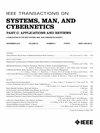Introduction to the Special Issue on Human-Robot Interaction
IEEE Transactions on Systems Man and Cybernetics Part C-Applications and Re
Pub Date : 2004-05-01
DOI:10.1109/TSMCC.2004.826271
引用次数: 96
Abstract
THIS SPECIAL issue is one of the products of the 2001 DARPA/NSF Study on Human–Robot Interaction. That study was commissioned by Jean Scholtz, then at the Defense Advanced Research Projects Agency (DARPA), and Vladmir Lumelsky, then at the National Science Foundation (NSF). The intent of the study and the details of the workshop that pro vided most of the source material are presented in the report by Burke, Murphy, Rogers, Scholtz, and Lumelsky, but the need for a survey of the state of the art of human–robot interaction should be clear. The past five years has seen an acceleration of the insertion of robots into the “everyday” world. Robots are no longer confined to the factory floor or Mars, but are serving as our museum guides, vacuuming our floors, searching for us in the aftermath of a disaster, and even acting as pets. The collection is intended to be a sampling of research efforts focused on human–robot interaction (HRI). The articles show that HRI has moved beyond the shallow interpretation of “in teraction,” meaning how to navigate around people in a room. HRI now embraces a richer perspective, including how to be able to directly aid a person with individual needs and prefer ences (see Hüttenrauch et al.), or how technology is inserted into complex tasks such as space exploration (Clancey), or existing organizations such as emergency response (see Murphy). Like wise human–robot interaction goes beyond multimodal user in terfaces which create a mechanism by which a human can direct a robot and instead drills into what a robot and person need to say to each other to accomplish a task (see Skubic et al.), how the system can help a user configure and coordinate multiple robots (see Endo et al.), and what the flavor of such interactions might be (see the two articles by Breazeal and the one by Lisetti et al.). Perhaps one lesson from the 2001 study is that HRI may be best thought of as a world view, a view much broader than even human-centered design. If we follow the taxonomy pos tulated in the article by Woods et al., there are three views of a human–robot system: that of the roboticist, the cognitive engineer, and the problem holder. The roboticist is concerned with making and programming robots. The cognitive engineer is interested in abstracting and applying lessons learned in how people adapt to technology. The problem holder is focused on how the technology solves the problem. HRI is a fusion of these three perspectives into a systems-oriented viewpoint. That said, perhaps the most telling indication of the state of the art of HRI is that almost each article in this issue takes a roboticist view point. Even in the most human-centered article, the needs and constraints of the robot continue to dominates any discussion of the system. As HRI research matures and robots become more capable, it is expected that neither the human nor the robot will be “centric,” but rather the system will be the true focus. This special issue finds that the field of human–robot interac tion is off to a good start but now must broaden its perspective to fully engage cognitive science, human-computer interaction, usability engineering, and the requirements of specific domains in order to fulfill the promise of truly usable robotic systems. We trust that you will find these articles a useful foundation for your investigations into this emerging area of inquiry.《人机交互》特刊导言
本特刊是2001年DARPA/NSF人机交互研究项目的成果之一。这项研究是由时任美国国防高级研究计划局(DARPA)的让·肖尔茨和时任美国国家科学基金会(NSF)的弗拉基米尔·卢梅尔斯基委托进行的。伯克、墨菲、罗杰斯、舒尔茨和卢梅尔斯基在报告中介绍了这项研究的意图和提供了大部分原始材料的研讨会的细节,但对人机交互技术的现状进行调查的必要性应该是明确的。过去5年,机器人进入“日常”世界的速度加快。机器人不再局限于工厂车间或火星,而是充当我们的博物馆导游,用吸尘器清扫我们的地板,在灾难发生后寻找我们,甚至充当宠物。该系列旨在成为集中在人机交互(HRI)研究工作的样本。这些文章表明,HRI已经超越了对“互动”的肤浅解释,即如何在房间里的人周围导航。人力资源研究所现在包含了一个更丰富的视角,包括如何能够直接帮助有个人需求和偏好的人(见h tenrauch等人),或者如何将技术插入复杂的任务,如太空探索(Clancey),或现有的组织,如应急响应(见墨菲)。像-明智的人机交互超越多通道用户terfaces创建一个机制,人类可以直接一个机器人,而是训练成一个机器人和人需要说什么彼此来完成一个任务(参见Skubic等。),该系统可以帮助用户如何配置和协调多个机器人(见Endo等。),以及这种交互作用的味道也许被布雷西亚(见的两篇文章还和一个Lisetti et al。)。也许从2001年的研究中得到的一个教训是,HRI最好被视为一种世界观,一种比以人为本的设计更广泛的观点。如果我们按照Woods等人在文章中提出的分类法,就会发现人-机器人系统有三种观点:机器人学家的观点、认知工程师的观点和问题持有者的观点。机器人学家关心的是制造和编程机器人。认知工程师感兴趣的是抽象和应用人们如何适应技术的经验教训。问题持有人关注的是技术如何解决问题。HRI是将这三种观点融合为面向系统的观点。也就是说,也许最能说明HRI技术现状的是,本期几乎每篇文章都采取了机器人专家的观点。即使在最以人为中心的文章中,机器人的需求和约束仍然主导着对系统的任何讨论。随着HRI研究的成熟和机器人能力的增强,预计人类和机器人都不会成为“中心”,而是系统将成为真正的焦点。这期特刊发现人机交互领域已经有了一个良好的开端,但现在必须扩大其视角,充分参与认知科学、人机交互、可用性工程和特定领域的需求,以实现真正可用的机器人系统的承诺。我们相信您会发现这些文章是您对这一新兴调查领域进行调查的有用基础。
本文章由计算机程序翻译,如有差异,请以英文原文为准。
求助全文
约1分钟内获得全文
求助全文
来源期刊
自引率
0.00%
发文量
1
审稿时长
3 months

 求助内容:
求助内容: 应助结果提醒方式:
应助结果提醒方式:


